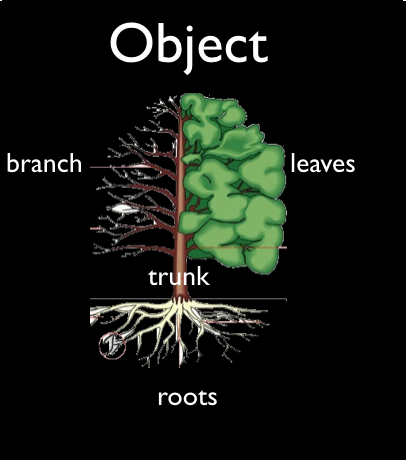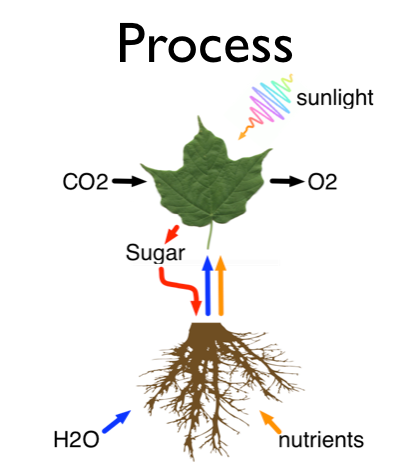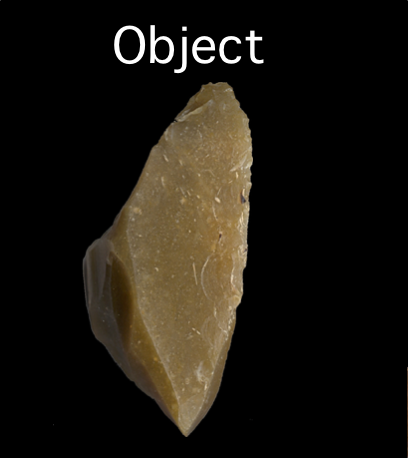Our difficulties understanding computers devolve from our problems perceiving processes. Our primary sense organ is our eyesight, and you cannnot see processes with your eyes; you see only objects. This bias towards objects shows up readily in our language. Of the 1,000 most frequently used words in the English language, about 600 are nouns, pronouns, or the adjectives that describe them. Only 300 are verbs or the adverbs that modify them. The remaining 100 words are “housekeeping” words such as articles or prepositions.
Thus, we use words about objects twice as often as we use words about processes. Here’s another example: when you look at a tree, what do you see? Do you see it as a collection of objects: branches, leaves, trunk, and roots?

When I look at a tree, I see processes: I see (with my mind’s eye) minerals dissolved in water in the soil seeping into the roots, slowly moving up the cambian up the trunk, out the branches to the leaves, where it combines with carbon dioxide in a photosynthetic process driven by sunlight to produce oxygen and adenosine triphosphate (ATP), which in turn is turned into sugars that travel through the tree to build more roots, more branches, and more leaves.

Perhaps I have a genetic mutation affecting my brain, because I can readily see processes all around me. I doubt that it’s genetic, though, because I have grown better at it as my education has advanced. Here’s another example, a rock I own:

What do you see when you look at this rock? Just a rock, right? You’re not really SEEING it. Look closely. Do you see those conchoidal marks along the right edge? Here, I’ll help out with a photograph of a piece of obsidian that has strong conchoidal marks:
NOW do you see the conchoidal marks on the rock? Good! Now at this point, you may be thinking “Big deal. So what if there are conchoidal marks on the rock?” If so, then you’re thinking exclusively in terms of objects. Think in terms of processes! What process could have made those conchoidal marks? There are at least two of them. What made them?
At this point, you need to have some education. It turns out the these kind of marks are always the result of a sharp blow delivered at a narrow spot on the rock. What could cause such a sharp blow? Well, if it were a big rock and fell onto another big rock with a sharp point, you could get conchoidal marks. But this brown rock is small. It could have fallen off a cliff and still not hit anything with enough force to fracture it conchoidally.
There’s only one plausible way that those two marks could have been made: somebody had to carefully strike it with a sharp-pointed rock at precisely the right position and angle to knock the chips off to make those marks. Such a strike would have broken off a thin flake of the rock, leaving behind a sharp edge.
This is not any old rock. This is a flint tool that was manufactured in France a few hundred thousand years ago. You looked at it and saw a brown rock. I look at it and see my heritage.
There’s just one trick you need to start learning to see the world in terms of processes: constantly ask yourself how things got to be the way they are. When you were a child, you had this kind of curiosity. You pestered your parents with questions about why the sky is blue. They got exasperated with you and said something like “Because it’s BLUE!” and that was the end of your process-curiosity. My dad answered my question with a technical answer that I couldn’t possibly understand, but it whetted my curiosity to understand.
By the way, the sky is blue because reddish photons from the sun pass right through the atmosphere, but bluish photons collide with molecules in the atmosphere that deflect them in myriad different directions. When you look up at the atmosphere, you see zillions of photons that bounced off molecules in that direction — blue photons. And the sky is blue for exactly the same reason that the sunset is red. You’ll have to figure that one out for yourself.
Next: the language of process
